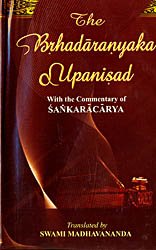Brihadaranyaka Upanishad
The Bṛhadāraṇyaka Upaniṣad (with the Commentary of Śaṅkarācārya)
by Swāmī Mādhavānanda | 1950 | 272,359 words | ISBN-10: 8175051027
This Upanishad is widely known for its philosophical statements and is ascribed to Yajnavalkya. It looks at reality as being indescribable and its nature to be infinite and consciousness-bliss. Ethics revolve around the five Yajnas or sacrifices. This book includes the english translation of the Bhāṣya of Śaṅkara. The Shankara-Bhashya is the most ...
Note
The Vedas, which are the oldest religious literature of the world, and are the highest authority with the Hindus in matters religious, consist of two main divisions—the Mantras and the Brāhmaṇas. Though the latter are a sort of commentary on the former, both have equal authority. A Mantra may be in verse, with fixed feet and syllables, when it is called Ṛc, or it may not have any ñxity of feet and syllables, when it is called Yajus. A Ṛc that can be sung is called a Sāman. These three classes of Mantras have been grouped into four compilations or Saṃhitās, which are called the Ṛg-Veda, the Yajur-Veda, the Sāma-Veda and the Atharva-Veda Samhitā. The common name for the first three is Trayī, which means a triad. The Vedas are also called Śrutis, as distinguished from the Smṛtis, under which comes all other sacred literature, and which derive their authority from the Śrutis.
The Vedas are claimed to be eternal. They are not the creation of man. Only they were revealed to certain highly spiritual persons, called Ṛṣis.
Each Saṃhitā had one or more Brāhmaṇas, only a few of which are extant. The Yajur-Veda, which has two forms, Dark and White, has the Taittirīya and Śatapatha Brāhmaṇas respectively. The White Yajur-Veda was revealed to Yajnavalkya through the grace of the Sun, who appeared to him in an equine form. Hence, by a derivative meaning, it is also called the Vājasaneyī Samhitā, and the Śatapatha Brāhmaṇa the Vājasaneyī Brāhmaṇa.
Some of the Brāhmaṇas have a portion called Āraṇyaka, in which, oftener than elsewhere, are found one or more Upaniṣads. The Upaniṣads constitute the Jnāna-Kāṇḍa, as treating of philosophy, while the rest of the Vedas is called Karma-Kāṇḍa, as dealing with rituals.
The Saṃhitās as well as the Brāhmaṇas had various recensions or śākhās according to their original teachers, after whom they were named. The Śatapatha Brāhmaṇa has the Kāṇva and Mādhyandina recensions, which differ greatly from each other in content as Well as the number and arrangement of their books and chapters, the former having seventeen Kāṇḍas or books, and the latter only fourteen. The Bṛhadāraṇyaka Upaniṣad forms the concluding portion of the last book, named ‘Āraṇyaka,’. of both recensions. But while the bulk of matter in both versions is the same, there are ṛnarked discrepancies too. Śaṅkara has commented upon the Kāṇva recension.
It may be mentioned in passing that this recension of the Śatapatha Brāhmaṇa is not only not in print, but is also not easily accessible in its entirety even in a manuscript form. This is all the more true of Sāyanācārya’s great commentary on this Brāhmaṇa.
